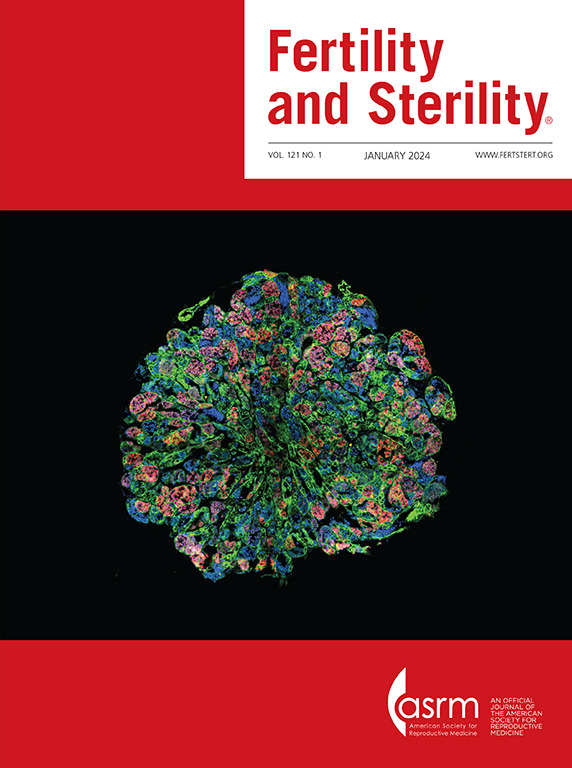The number of autologous, vitrified mature oocytes needed to obtain three euploid blastocysts increases with age.
IF 6.6
1区 医学
Q1 OBSTETRICS & GYNECOLOGY
引用次数: 0
Abstract
OBJECTIVE To determine the number of mature oocytes required to make at least three euploid blastocysts DESIGN: Retrospective cohort study SUBJECTS: All patients at a multi-center assisted reproductive technology (ART) practice that warmed vitrified autologous oocytes for IVF from 2011 to October 2023 EXPOSURE: Warming oocytes. MAIN OUTCOME MEASURE(S) Number of mature (MII) oocytes to achieve at least three euploid blastocysts. RESULTS 1,041 thaw cycles from 986 patients were analyzed. Patients were stratified by age at vitrification. Measures of ovarian reserve decreased with advancing age, as expected. Number of mature oocytes (MII) banked and euploid blastocysts available decreased as age at vitrification increased. Patients aged 35-40 used preimplantation genetic testing more than those older than 40 or younger than 35. To optimize the chance of a potential live birth by banking at least three euploid blastocysts, patients less than 35 at vitrification needed a mean of 15 MIIs. This number doubled in patients 38 or older and tripled for patients older than 40. We also analyzed potential live birth per number of MII banked, which also increased with age, with 0.13 expected live births per thawed MII oocyte at less than 35, and 0.04 expected live births if older than 40 at time of oocyte vitrification. Age at vitrification was more influential than indication for vitrification for expected outcome of live birth. CONCLUSION From previously published literature, 3 euploid blastocysts provided a 93% chance of a child. From our analysis, patients required an average of 15 mature oocytes to yield at least 3 euploid blastocysts if they were less than 35 at time of vitrification. The required number of MII doubled in patients aged 38 and older, and tripled in those 40 and older, to achieve the same goal. Given our results, we should encourage egg freeze patients to cryopreserve before age 38. We should also counsel patients that multiple vitrification cycles will likely be required to achieve a high probability of live birth from future oocyte thaws for women aged 38 or older.获得三个整倍体囊胚所需的自体玻璃化成熟卵母细胞的数量随着年龄的增长而增加。
目的:确定制造至少三个整倍体囊胚所需的成熟卵母细胞数量设计:回顾性队列研究对象:2011年至2023年10月,所有接受多中心辅助生殖技术(ART)治疗的患者,该治疗采用加热玻璃化自体卵母细胞进行体外受精。主要观察指标(S)形成至少三个整倍体囊胚的成熟卵母细胞数量。结果对986例患者的1041个解冻周期进行分析。患者按玻璃化时的年龄分层。正如预期的那样,卵巢储备指标随着年龄的增长而下降。成熟卵母细胞(MII)和整倍体囊胚数量随着玻璃化年龄的增加而减少。35-40岁的患者比40岁以上或35岁以下的患者更常进行胚胎植入前基因检测。为了通过储存至少三个整倍体囊胚来优化潜在活产的机会,玻璃化时小于35岁的患者平均需要15个mii。这个数字在38岁及以上的患者中翻了一番,在40岁以上的患者中翻了三倍。我们还分析了每个MII卵库数量的潜在活产率,这也随着年龄的增长而增加,每个解冻的MII卵母细胞在小于35岁时预期活产率为0.13,如果卵母细胞玻璃化时大于40岁,则预期活产率为0.04。玻璃化手术年龄比玻璃化手术指征对活产预期结果的影响更大。结论从先前发表的文献来看,3个整倍体囊胚提供了93%的孩子机会。从我们的分析来看,如果患者在玻璃化时小于35个成熟卵母细胞,则平均需要15个成熟卵母细胞才能产生至少3个整倍体囊胚。为了达到同样的目标,38岁及以上的患者所需的MII数量增加了一倍,40岁及以上的患者所需的MII数量增加了两倍。鉴于我们的结果,我们应该鼓励卵子冷冻患者在38岁之前进行冷冻保存。我们还应该提醒患者,对于38岁或以上的女性,为了获得高概率的活产,可能需要多次玻璃化周期。
本文章由计算机程序翻译,如有差异,请以英文原文为准。
求助全文
约1分钟内获得全文
求助全文
来源期刊

Fertility and sterility
医学-妇产科学
CiteScore
11.30
自引率
6.00%
发文量
1446
审稿时长
31 days
期刊介绍:
Fertility and Sterility® is an international journal for obstetricians, gynecologists, reproductive endocrinologists, urologists, basic scientists and others who treat and investigate problems of infertility and human reproductive disorders. The journal publishes juried original scientific articles in clinical and laboratory research relevant to reproductive endocrinology, urology, andrology, physiology, immunology, genetics, contraception, and menopause. Fertility and Sterility® encourages and supports meaningful basic and clinical research, and facilitates and promotes excellence in professional education, in the field of reproductive medicine.
 求助内容:
求助内容: 应助结果提醒方式:
应助结果提醒方式:


